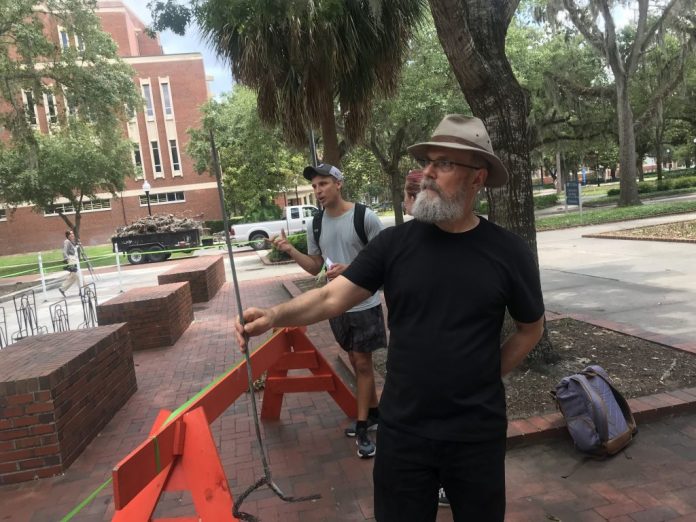Twenty years ago, Jack Davis began teaching environmental history at the University of Florida. Most workdays, outside his classroom, he greeted one of the university’s oldest residents: the tall, long-leaved pine nicknamed the “Bicentennial Tree.”
Davis became aware of the tree’s presence near Keene-Flint Hall on the north edge of campus after arriving at UF; An employee quickly drew his attention to this. At the base of the tree is a concrete plaque with his name and age, but time and the elements of Florida have eroded it so badly that it’s difficult to read.
Earlier this year, Terry Harpold, a professor of English at UF, told Davis the tree was dead and needed to be cut down. Davis noted the tree’s slow decline last fall when it “appeared anemic and showed no needle growth.”
An arborist safely removed the tree this week, and now Davis and others are saddened to know the tree is gone.
“I enjoy sharing with my students what the history of this tree may have witnessed,” Davis said. “Like the Aboriginal presence, the Spanish, the British, the early settlers, the construction of the university, the many demonstrations of the 1960s at the university, and the first Earth Day in 1970.”
Davis said the tree is easy to spot because it has a lightning cable running down its trunk and it has an older appearance.
Associate Professor Terry Harpold holds the lightning rod that was inside the Bicentennial Tree. (Elliot Tritto/WUFT News)
“I live a block or two from Tom Petty Park and there are a lot of Scots Pines, but not nearly as old as this one,” Davis said. “There’s probably no one there that’s a hundred years old, but I’ve seen so many of them die over the years when they’ve been stressed.”
Davis said the tree has witnessed not only human history but also the ecological history of the region. He wants to remind people that trees have a life of their own outside of humanity.
The tree could not be felled when the university was built a century ago, and Davis was reminded that no matter how old or how healthy the tree is, it is always in danger.
There is no evidence that the Bicentennial tree was the oldest tree in UF. Still, the curiosity to discover UF’s oldest tree began with Harpold’s sustainability education literature.

Harpold led a memorial service in front of students, faculty and staff. With a ten-minute speech, he helped mark the beginning of the end of the jaws. Harpold led efforts to preserve the memory of the tree, considering it a living archive of a planet in need.
“From working with the wonderful people here in garden maintenance, I know that nobody has ever done anything like this,” said Harpold. “No one has ever felled such an old tree on campus and set out to preserve it.”
Harpold ended the service by reading When Great Trees Fall by Maya Angelou.
As the trees were cut down, sawdust began to scatter.
“It smells like Christmas,” said Florence Turcotte, archivist of literary manuscripts at Smathers Library on campus.
 A group of students, staff and faculty gather around the tree to listen to Terry Harpold read Maya Angelou’s poem When Great Trees Fall. (Elliot Tritto/WUFT News)
A group of students, staff and faculty gather around the tree to listen to Terry Harpold read Maya Angelou’s poem When Great Trees Fall. (Elliot Tritto/WUFT News)
Harpold said it wasn’t easy to determine which oldest living tree on campus it was because there was no definitive evidence. After making a few calls and emails to find the answer, he heard from Dr. Michael Andreu, Associate Professor at the School of Forest Fisheries and Geomatic Sciences.
Andreu referred to Keene-Flint Hall’s “very old tree”.
One of Harpold’s students, Brooke Whittaker, an English second-year PhD student, suggested doing a thesis on the tree’s long lifespan.
Whittaker said she came across an alligator article dated Jan. 16, 1976, in which Noel Lake, UF’s director of landscapes, and other members of the forestry faculty referred to it as a “bicentennial tree.”
“I think they found it by finding nearby felled trees based on that age range. They could tell it was essentially 1776,” Whittaker said.
Andreu has been teaching tree and plant courses for 13 years. He said one of his last courses focused on urban trees and he will always make sure his students walk by the tree. He only found out about the age of the tree when Whittaker was writing his thesis.
“Some of the research Brooke has done that correlates the rise in global average levels of atmospheric carbon dioxide with methane and other greenhouse gases and maps the age of the tree on an accelerating chart is very powerful information,” Andreu said.
He said that longleaf pines like this one can live up to 300 years and even 500 years and are exposed to many different stressors. Andreu added that the tree is around 275 years old and have found no evidence that the tree was killed by a lightning strike or that there was any insect infestation.
“It could just succumb to a whole bunch of stressors that ultimately brought it down,” Andreu said. “It doesn’t appear that anything killed the tree.”
After Harpold broke the news to Thomas Schlick, the assistant director for Facility Services, Grounds and Natural Resources, he immediately wanted to find a way to preserve the tree.
In addition, they hope to determine the exact age of the tree by taking some cores while curing cross-sections from the tree for inclusion in a future exhibition.
Davis spends his free time crafting wood and said he would like to make a small bench or drawer out of the wood.
“I hope this will lay the groundwork for the university and draw attention to sustaining more residents,” Harpold said.
www.wuft.org
https://www.wuft.org/news/2023/05/18/uf-group-holds-memorial-service-for-one-of-campus-oldest-residents-the-bicentennial-tree/











